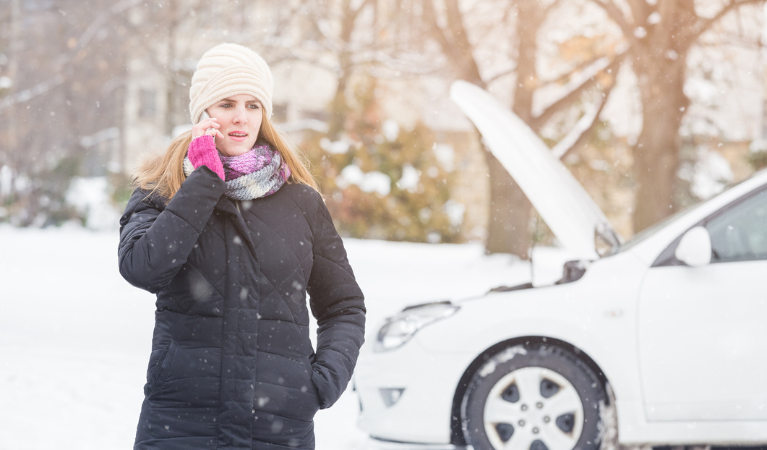Warning: Fraudsters are using our brand to target individuals. Loans 2 Go will never ask for upfront fees. If affected, please contact us & learn more here.
We use cookies to improve your experience on our websites and to analyse how and when our sites are used. By clicking 'Accept all & continue' you're agreeing to our use of cookies. To learn more about the cookies we use, you can read our cookie policy.
Opt out of non-essential cookiesWarning: Fraudsters are using our brand to target individuals. Loans 2 Go will never ask for upfront fees. If affected, please contact us & learn more here.

At Loans 2 Go we have a series of helpful articles that provide guidance as to what to do in case of some kind of domestic disaster. A list of previous articles appears at the end of this one.
One topic that is particularly important at the moment is what to do if your car breaks down. Winter is a tough time for drivers in many ways, and a breakdown is the last thing you want to happen. But if it does, it helps enormously to be prepared.
So in this article we look at:
If your car breaks down, there are different things to do depending where you are when it happens. We are going to look at what to do if you break down:
If your car breaks down at home, and you have breakdown cover that includes Home Start, this is the best option to go for. Or even if you have breakdown cover that does not include Home Start, it may be possible to contact the company and add it on as an option.
Most kinds of Home Start cover will either repair your car at your home or, if this is not possible, take your car to a local garage.
If you don’t have breakdown cover, the first thing to do is think about whether you know anyone who could help. Do you have a friend who is good with cars? Or is there a mobile mechanic living near you that does car repairs in your area?
If neither of these options works out, the best thing to do is to contact a local garage for advice. They may either be able to send someone to check out your car at home, or arrange for it to be transported to their garage to be repaired.
If you break down on a small A or B road, the first thing to do is to try and get as far off the road as possible. If you can’t get your car out of the way of other vehicles, call the police for assistance.
Put your car hazard lights on, and if you have a warning triangle put it a little way behind your vehicle if it’s safe to do so. This alerts other road users to the situation.
Also get passengers out of the car and to a palace of safety. Make sure that everyone is as visible as possible – if necessary leave sidelights on.
Once the car and your passengers are as safe as you can make them, call your breakdown service if you have them. If not, you may be able to join a service such as the RAC and AA instantly by phone. Otherwise you will need to start phoning local garages for help.
If you break down on a motorway, you need to get off the road if at all possible. Try to make it to the hard shoulder or, if it is a smart motorway, to the next emergency refuge area.
If you cannot get off the main carriageway, get as far to the left as you can and put your hazard lights on. Call the police immediately. On a smart motorway, your breakdown should also be picked up by a remote control centre, who will block off lanes as needed.
Get everyone out of the car if it is safe to do so and get them behind the crash barrier. Official advice is to leave pets in the car with a window slightly open unless you can get them well away from the road to a place of safety.
Call your breakdown service. Emergency phones are available at regular intervals if there are any issues with your mobile phone.
Whilst it’s essential to know what to do in the event of a breakdown, it’s also really important to do all you can to avoid a breakdown in the first place. Let’s take a look:
The RAC uses a very helpful acronym FORCES to remind us of all the essential checks that we should all do regularly on our cars, but particularly before making a long journey. These six checks can help to reduce your chances of a breakdown this winter:
Make sure that you have enough before you set out. If you get stuck in traffic your car will use more fuel than normal. The same applies if you have an electric car : ensure it is fully charged before you leave. And throughout your journey, take opportunities to refuel or recharge regularly rather than leaving it till you are nearly empty.
Checking your oil level regularly and topping up as needed is a key part of keeping your engine in tip top condition, enabling your car to perform at its best.
Check that all four tyres have 2-3mm of tread and that they are inflated to the correct pressure. This will enable them to maintain good grip in wet or icy conditions. Also check your wiper blades for wear and tear: if they are not clearing the windscreen of rain properly they will be even less effective at tackling snow.
Your radiator should contain approximately a 50/50 mix of water and antifreeze. Check your levels and ensure you have the right mix.
Make sure all of your lights are working and replace any faulty bulbs or blown fuses. Also check your battery. If it’s either over five years old, or is struggling to start the car, now is the time to get it replaced.
Check that your windscreen washer fluid is fully topped up and contains a high concentration of good quality screenwash.
The first rule of winter driving is to take the time to clear your car windscreen properly before setting off. Not only is this sensible advice, it is also a legal requirement. The Highway Code stipulates that if driving in adverse weather conditions you must, by law, be able to see out of every glass panel in your vehicle.
So even if you are only going on a short journey you need to clear your windows of snow, ice or condensation, and make sure that there is no snow on any part of the car that could move and block your view.
Once you are on the road, you may also need to adjust your driving techniques to keep yourself and others safe. If there is snow or ice, take extra care by following these five tips:
Recent images of drivers stranded on roads and having to take overnight refuge in pubs make us think about what we would do in that situation. One aspect of this is to consider what you would need if you either get stuck in your car due to a snowdrift or major traffic jam, or breakdown and have to abandon your car.
So when setting off on a long winter journey, some of the following are worth taking with you.
We hope that the above information will help you to know what to do if your car breaks down, and to do all that you can to prevent it happening in the first place.
Also check out or previous articles on what to do in the event of other domestic disasters:
Remember that if you are facing a car breakdown or any other kind of domestic disaster, an emergency loan from Loans 2 Go may be able to help you sort things out.
Do visit us here again soon for more financial and lifestyle tips from Loans 2 Go.











Loans 2 Go is a trading name of Loans 2 Go Limited, registered in England and Wales. Company number 4519020. ICO registration number Z720743X. Registered address: Bridge Studios, 34a Deodar Road, London SW15 2NN. Authorised and regulated by the Financial Conduct Authority (FRN 679836). *Payment by bank transfer once application approved, subject to our working hours of Monday to Friday: 8am to 8pm and Saturday 8am to 5pm. All loans are subject to eligibility & affordability criteria. Max APR 815.6%. Minimum repayment period 18 months. Maximum repayment period 24 months.
As a lender, we pay commissions to credit brokers or other intermediaries who introduce customers to us. The commission we pay varies depending on the broker, the product offered, and the terms agreed with the broker. This payment is made by us and does not affect the interest rate, terms, or total cost of your loan.
© 2024 Loans 2 Go. All rights reserved.